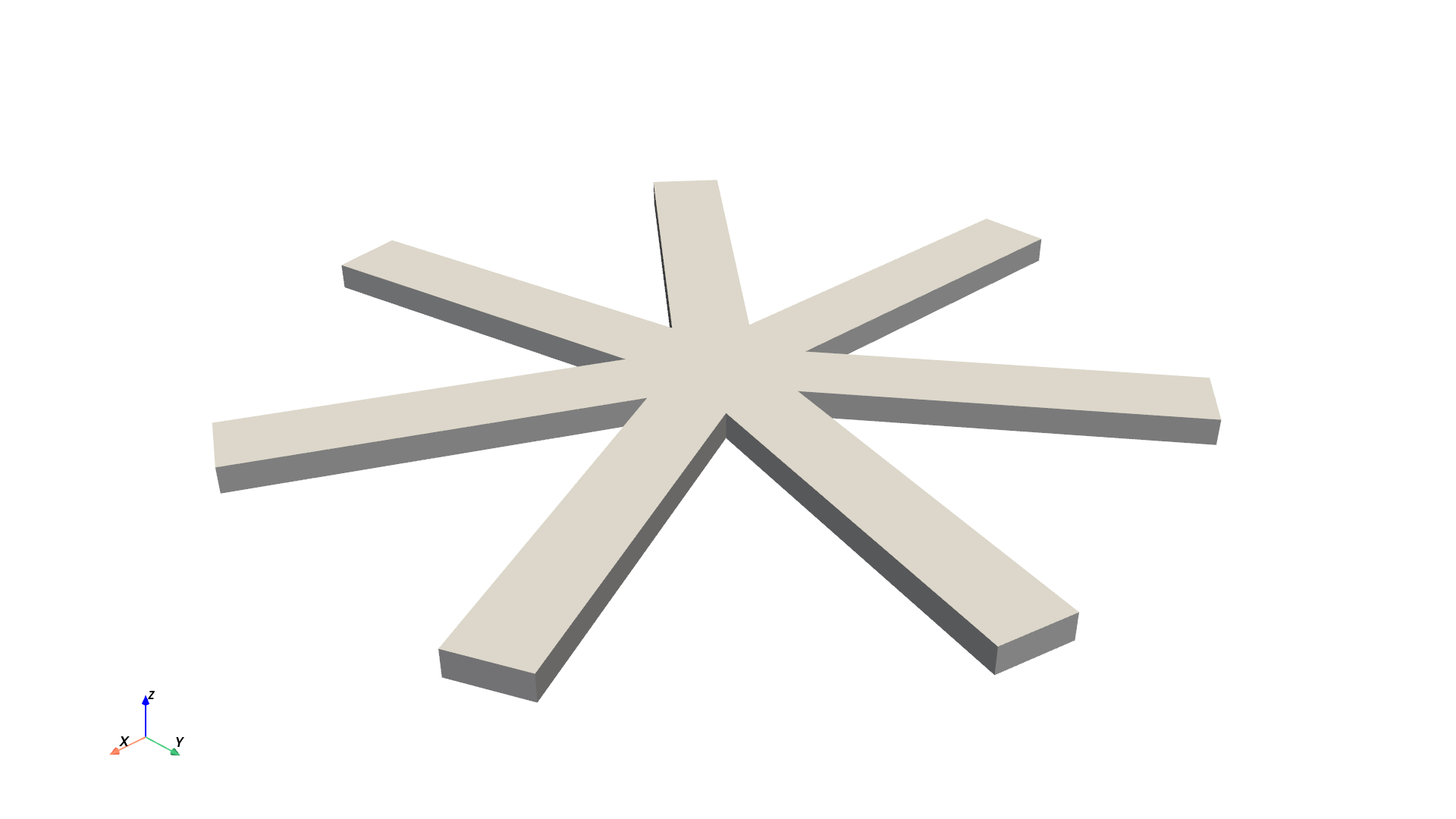注釈
Go to the end to download the full example code.
Cyclic Analysis#
This example creates a bladed disc using parametric geometry of a cyclic sector and then runs a modal analysis on that cyclic sector. We then post-process the results using the legacy MAPDL reader and finally generate another cyclic model using our parametric modeler.
Our first task is to create a simple cyclic model with 7 sectors.

First, start MAPDL as a service.
import numpy as np
import pyvista as pv
from ansys.mapdl.core import launch_mapdl
mapdl = launch_mapdl()
Create the Cyclic Sector#
Create a single "sector" of our cyclic model.
def gen_sector(mapdl, sectors):
"""Generate a single sector within MAPDL."""
# thickness
thickness = 0.003 # meters
arc_end = 2 * np.pi / sectors
arc_cent = arc_end / 2
# radius
rad = 0.01 # M
arc = pv.CircularArc(
[rad, 0, 0],
[np.cos(arc_end) * rad, np.sin(arc_end) * rad, 0],
[0, 0, 0],
)
# interior circle
kp_begin = [rad, 0, 0]
kp_end = [np.cos(arc_end) * rad, np.sin(arc_end) * rad, 0]
kp_center = [0, 0, 0]
# exterior circle in (M)
out_rad = 5.2e-2
# solve for angle to get same arc.length at the end
cent_ang = arc.length / out_rad / 2
# interior circle
kp_beg_outer = [
np.cos(arc_cent - cent_ang) * out_rad,
np.sin(arc_cent - cent_ang) * out_rad,
0,
]
kp_end_outer = [
np.cos(arc_cent + cent_ang) * out_rad,
np.sin(arc_cent + cent_ang) * out_rad,
0,
]
mapdl.prep7()
mapdl.k(0, *kp_center)
mapdl.k(0, *kp_begin)
mapdl.k(0, *kp_end)
mapdl.k(0, *kp_beg_outer)
mapdl.k(0, *kp_end_outer)
# inner arc
mapdl.l(1, 2) # left line
mapdl.l(1, 3) # right line
lnum_inter = mapdl.l(2, 3) # internal line
mapdl.al("all")
# outer "blade"
lnum = [lnum_inter, mapdl.l(4, 5), mapdl.l(2, 4), mapdl.l(3, 5)]
mapdl.al(*lnum)
# extrude the model in the Z direction by ``thickness``
mapdl.vext("all", dz=thickness)
# generate a single sector of a 7 sector model
sectors = 7
gen_sector(mapdl, sectors)
# Volume plot
mapdl.vplot()
Make the Model Cyclic#
Make the model cyclic by running Mapdl.cyclic()
Note how the number of sectors matches
output = mapdl.cyclic()
print(f"Expected Sectors: {sectors}")
print(output)
Generate the mesh#
Generate the finite element mesh using quadritic hexahedrals, SOLID186.
# element size of 0.01
esize = 0.001
mapdl.et(1, 186)
mapdl.esize(esize)
mapdl.vsweep("all")
# plot the finite element mesh
mapdl.eplot()
Apply Material Properties#
# Define a material (nominal steel in SI)
mapdl.mp("EX", 1, 210e9) # Elastic moduli in Pa (kg/(m*s**2))
mapdl.mp("DENS", 1, 7800) # Density in kg/m3
mapdl.mp("NUXY", 1, 0.3) # Poisson's Ratio
# apply it to all elements
mapdl.emodif("ALL", "MAT", 1)
Run the Modal Analysis#
Let's get the first 10 modes. Note that this will actually compute
(sectors/2)*nmode based on the cyclic boundary conditions.
output = mapdl.modal_analysis(nmode=10, freqb=1)
print(output)
Get the Results of the Cyclic Modal Analysis#
Visualize a traveling wave from the modal analysis.
For more details, see Validation of a Modal Work Approach for Forced Response Analysis of Bladed Disks, or the Cyclic Symmetry Analysis Guide
注釈
This uses the legacy result reader, which will be deprecated at some point in favor of DPF, but we can use this for now for some great animations.
For more details regarding cyclic result post processing, see: - Understanding Nodal Diameters from a Cyclic Model Analysis - Cyclic symmetry examples
# grab the result object from MAPDL
result = mapdl.result
print(result)
List the Table of Harmonic Indices#
This is the table of harmonic indices. This table provides the corresponding harmonic index for each cumulative mode.
print("C. Index Harmonic Index")
for i, hindex in zip(range(result.n_results), result.harmonic_indices):
print(f"{i:3d} {hindex:3d}")
Generate an Animation of a Traveling Wave#
Here's the nodal diameter 1 of first bend on our cyclic analysis.
We can get the first mode (generally first bend for a bladed rotor) for nodal diameter 1 with:
mode_num = np.nonzero(result.harmonic_indices == 1)[0][0]
pv.global_theme.background = "w"
_ = result.animate_nodal_displacement(
11,
displacement_factor=5e-4,
movie_filename="traveling_wave11.gif",
n_frames=30,
off_screen=True,
loop=False,
add_text=False,
show_scalar_bar=False,
cmap="jet",
)
And here's 1st torsional for nodal diameter 3.
_ = result.animate_nodal_displacement(
36,
displacement_factor=2e-4,
movie_filename="traveling_wave36.gif",
n_frames=30,
off_screen=True,
loop=False,
add_text=False,
show_scalar_bar=False,
cmap="jet",
)
Parametric Geometry#
Since our geometry creation is scripted, we can create a structure with any number of "sectors". Let's make a more interesting one with 20 sectors.
First, be sure to clear MAPDL so we start from scratch.
mapdl.clear()
mapdl.prep7()
# Generate a single sector of a 20 sector model
gen_sector(mapdl, 20)
# make it cyclic
mapdl.cyclic()
# Mesh it
esize = 0.001
mapdl.et(1, 186)
mapdl.esize(esize)
mapdl.vsweep("all")
# apply materials
mapdl.mp("EX", 1, 210e9) # Elastic moduli in Pa (kg/(m*s**2))
mapdl.mp("DENS", 1, 7800) # Density in kg/m3
mapdl.mp("NUXY", 1, 0.3) # Poisson's Ratio
mapdl.emodif("ALL", "MAT", 1)
# Run the modal analysis
output = mapdl.modal_analysis(nmode=6, freqb=1)
# grab the result object from MAPDL
result = mapdl.result
print(result)
List the Table of Harmonic Indices#
Note how the harmonic indices of these modes goes up to 10, or N/2 where N is the number of sectors.
print("C. Index Harmonic Index")
for i, hindex in zip(range(result.n_results), result.harmonic_indices):
print(f"{i:3d} {hindex:3d}")
Plot First Bend for Nodal Diameter 2#
Note how you can clearly see two nodal lines for this mode shape since it's nodal diameter 2.
result.plot_nodal_displacement(
12, cpos="xy", cmap="jet", show_scalar_bar=False, add_text=False
)
Animate First Bend for Nodal Diameter 2#
Let's end this example by animating mode 12, which corresponds to first bend for the 2nd nodal diameter of this example model.
_ = result.animate_nodal_displacement(
12,
displacement_factor=2e-4,
movie_filename="traveling_wave12.gif",
n_frames=30,
off_screen=True,
loop=False,
add_text=False,
show_scalar_bar=False,
cmap="jet",
)

